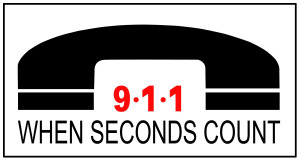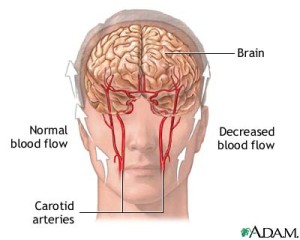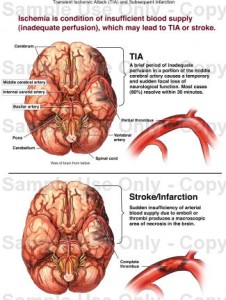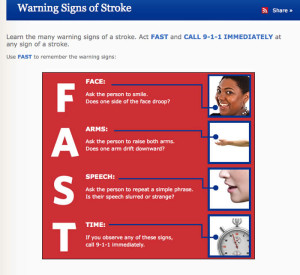Chronic Disease in the United States – Stroke
This week the focus of my thoughts for the blog post has moved to strokes, sometimes called a brain attack. A stroke occurs when a blood clot blocks the blood supply to the brain or when a blood vessel in the brain bursts. Anyone can have a stroke, including children, and some risk factors are beyond your control such as age, sex and ethnicity.
Stroke risk varies by race and ethnicity and is the fourth leading cause of death for Americans. Risk of having a first stroke is nearly twice as high for blacks than for whites and blacks are more likely to die following a stroke than are whites. Hispanics risk of stroke falls between that of whites and blacks. American Indians, Alaska Natives, and blacks are more likely to have had a stroke than are other groups.
Stroke risk increases with age, but stroke can, and does, occur at any age. In 2009, 34% of people hospitalized for stroke were younger than 65 years. The prevalence of stroke between men and women is pretty much the same except between the ages of 20 – 39 and 60 – 79 when a slightly higher percentage of women were afflicted from 2007 – 2010 according to the American Heart Assn.
Signs of Stroke
We hear it often, but it never hurts to be reminded when it could be the difference between strength and disability, life and death, so here are five warning signs of stroke in men and women:
- Sudden numbness or weakness in the face, arm or leg – especially on one side of the body.
- Sudden confusion, trouble speaking, or difficulty understanding speech.
- Sudden trouble seeing in one or both eyes.
- Sudden trouble walking, dizziness, loss of balance or lack of coordination.
- Sudden severe headache with no known cause.
Call 9-1-1 immediately if you or someone else has any of these symptoms. 
Also, if you think someone may be having a stroke, act F.A.S.T. and do the following simple test:
F – Face: Ask the person to smile. Does one side of the face droop?
A – Arms: Ask the person to raise both arms. Does one arm drift downward?
S – Speech: Ask the person to repeat a simple phrase. Is there speech slurred or strange?
T – Time: If you observe any of these signs, call 911 immediately.
Risk Factors
Several conditions and certain lifestyle choices can put you at a higher risk for stroke. The most important risk factors are:
- High blood pressure
- Heart disease
- Diabetes
- Cigarette smoking
- Prior Stroke
Reducing Risk
There are several steps you can take to reduce your risk for stroke:
- Eat a healthy diet
- Maintain a healthy weight
- Be physically active
- Don’t smoke
- Limit alcohol use
- Prevent or treat high cholesterol
- Prevent or treat high blood pressure
- Prevent or treat diabetes
If you think you or someone you love is having a stroke, acting quickly to get medical treatment lowers your risk of disability or even death, so recognizing the symptoms and getting help is extremely important.
Following are several different types of strokes that can affect a person.
- TIA – Transient Ischemic Attack
This is often labeled “mini-stroke”, it is more accurately characterized as a “warning stroke” and is a warning you should take very seriously.
TIA is caused by a clot, the only difference between a stroke and a TIA is that with TIA the blockage is transient (temporary). TIA symptoms occur rapidly and last a relatively short time. Most TIAs last less than five minutes; the average is about a minute. When a TIA is over, it usually causes no permanent injury to the brain.
- Ischemic Strokes (Clots)
Ischemic stroke accounts for about 87 percent of all cases.
Ischemic strokes occur as a result of an obstruction within a blood vessel supplying blood to the brain. The underlying condition for this type of obstruction is the development of fatty deposits lining the vessel walls, which is called atherosclerosis. The fatty deposits can cause two types of obstruction:
- Cerebral thrombosis – blood clot that develops at the clogged part of the vessel.
- Cerebral embolism – this term generally refers to a blood clot that forms at another location in the circulatory system, usually the heart and large arteries of the upper chest and neck. A portion of the blood clot breaks loose, enters the bloodstream and travels through the brain’s blood vessels until it reaches vessels too small to let it pass. A second important cause of embolism is an irregular heartbeat, known as atrial fibrillation. A-fib creates conditions where clots can form in the heart, dislodge and travel to the brain.
- Hemorrhagic Strokes (Bleeds)
Hemorrhagic stroke accounts for about 13 percent of stroke cases and results from a weakened vessel that ruptures and bleeds into the surrounding brain. The blood accumulates and compresses the surrounding brain tissue.
Two types of weakened blood vessels usually cause hemorrhagic stroke: aneurysms and arteriovenous malformations or AVMs.
- An aneurysm is a ballooning of a weakened region of a blood vessel. If left untreated, the aneurysm continues to weaken until it ruptures and bleeds into the brain.
- An arteriovenous malformation (AVM) is a cluster of abnormally formed blood vessels. Any one of these vessels can rupture, also causing bleeding into the brain.
May is American Stroke Month – a good practice would be to make sure your family and friends know the warning signs of a stroke by reviewing the act F.A.S.T. test.
Spring has finally arrived! It is my hope that you will be able to get outside and enjoy the weather and have fun being active.
To your good health,
Barb




